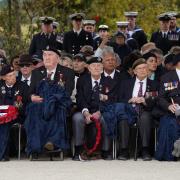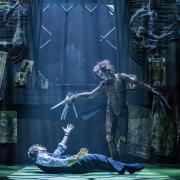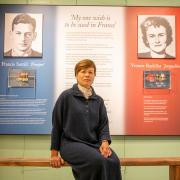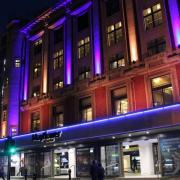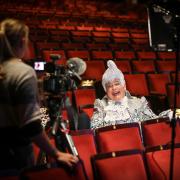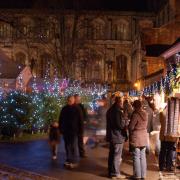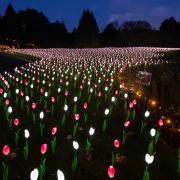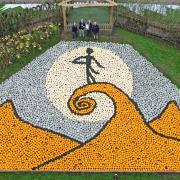First on the scene in a crisis, the Chinook helicopter is designed to operate in an emergency, but for the service men and women at RAF Odiham saving lives is in their blood as Viv Micklefield discovers on a tour ‘inside the wire’

A brief flypast
• 1937 Luftwaffe Chief of Staff, General Erhard Milch officially opens RAF Odiham, reputedly later ordering pilots against bombing his ‘future HQ’.
• 1940s Mustangs and Typhoons arrive as Fighter Command takes control; the Free French Air Force and the Royal Canadian Air Force also establish bases here.
• 1944 Post D-Day a Prisoner of War Reception Centre is set-up.
• 1948 Six Vampires take off, completing the first trans-Atlantic jet crossing.
• 1953 The Royal Review sees the largest ever gathering of RAF aircraft and personnel.
• 1955 The RAF’s first Hunter aircraft acrobatics team, The Black Knights are formed.
• 1960 Becomes a helicopter base, initially, for Wessex and Pumas.
***
Whether delivering food aid to typhoon hit islands in the Philippines or transporting medics to the war zones of Afghanistan, the Royal Air Force’s most adaptable helicopter, the Chinook, attracts well-earned respect both from those on the ground and from her pilots. It is though, just the latest in an incredible line-up of aircraft witnessed in the skies above the north Hampshire village of Odiham.
Back in the mid 1920s, few local residents could have imagined that the grazing land used by the military as a summer airfield would today be the RAF’s southern-most station and arguably, one of its most important. At 750 acres, it’s almost four times its original size; a vast expanse of tarmac and brick that in addition to housing the latest hi-tech equipment, includes workshops, welfare blocks and the Operations Wing HQ.
“The phone rings and it could be about anything,” says Group Captain Richard Maddison, Station Commander and the man currently in charge of the country’s three squadron-strong Chinook force. The versatile copter first arrived in Odiham in 1980 and there is now an expanding fleet of almost 50, operating frontline helicopter support on behalf of NATO.
“In addition to taking-off for global hotspots, there’s a duty of National Standby”, Richard adds. “The Ministry of Defence’s first priority is the protection of the UK and its dependent territories, so we have an aircraft which is available 24 hours a day and a crew ready, in case there’s a call-up. There was an emergency on the Isle of Wight during this year’s flooding; we lifted some army units and their vehicles over. Just 40 minutes later they were on the ground with their equipment.
“The Chinook has an unmatched capability, there’s nothing else that can lift a ten tonne load. Most people recognise this helicopter and they know that when things are going wrong anywhere in the world, we’ll probably be at the heart of it, helping out.”
The rapid deployment of personnel and equipment has indeed become RAF Odiham’s calling card. Whether landing in the middle of a desert storm or hovering above a pitching ship, the pilots must be incredibly skilled and this takes hours of practice. While the sound of the twin rotor blades whirring overhead gets many a seven-year-old jumping with excitement, Richard’s conscious of the station being branded as a noisy neighbour.
“We ‘export’ as much of our training as we can,” he says. “I’ve had four aircraft in California doing dust training, and there are crews using the simulator at RAF Benson (in Oxfordshire). We need to do a certain amount of real flying from here though and, generally, the support we get is just amazing.” He continues: “We do try to be very aware of our surroundings, particularly with the horse riding community. The more they are exposed to aircraft, the more the animals become desensitised to them so the greater problems arise sometimes when we go further afield.”
The team also values the ongoing assistance of local landowners who, by giving their permission to use fields or confined areas surrounded by trees, allow inexperienced Chinook pilots to perfect their skills.
“It’s just a great aircraft to fly,” says Flight Lieutenant Andy Wright, whose service record includes Northern Ireland, Iraq and the Falklands; having initially trained as a navigator within the four-man Chinook crew. “We’re known in Afghanistan for working with the immediate reaction teams. We’ll take doctors and nurses straight to a casualty and then fly the injured personnel back to the nearest hospital. Over the last eight years that’s been our raison d’etre.”
Flight Lieutenant Chris Gent, a veteran of seven such tours, adds: “As a pilot or operator it’s really rewarding knowing you’ve made a difference. Everyone understands what they need to do. It’s very slick and professional.” A modest comment from someone awarded the Queen’s Commendation for Bravery in the Air following a dangerous rescue operation in 2012.
Whatever their call of duty, returning home to a tight-knit station and a warm Hampshire welcome is appreciated by all the service personnel. Honorary citizenship conferred upon the local commander and officers reinforces this close relationship, as does the granting of the Freedom of the Borough of Basingstoke. “The base has been here so long it’s a real part of the community,” acknowledges Chris. “With Odiham village just down the road we’ve done a number of parades; the last one was for Armed Forces Day in 2013 when the bunting was out and everyone was waving flags. It was a real sense of occasion.”
Not surprisingly, with almost 40 different squadrons having passed through its hangars and mess rooms, the station still echoes its rich and colourful past. Emsworth resident Michael Andrae (No. 247 Sqn) worked here as an armourer on Vampires and Meteors during the Cold War stand-off. Returning recently for the first time in over 60 years he observes: “There is a calm efficiency and you get a real sense of purpose everywhere. I’m proud to have been a very small part of it.”
With no shortage of former pilots’ log books displayed in archive rooms and captured enemy flags adorning mess room walls, today’s RAF Odiham displays a genuine desire to commemorate the achievements of previous generations. However, as plans to mark the centenaries of No. 18 and No. 27 Squadrons take shape, the next 12 months will also see the station meet its 21st century challenges.
New living accommodation has already been built, with an improved engineering hub next in line. And, in addition to upgrading the technical capability of the existing fleet, the first Mark 6 Chinooks complete with digital cockpits and advanced avionics, such as automatic hover control, have already been tested and released into service.
As the withdrawal of operations in Afghanistan signals the end of another chapter in RAF Odiham’s illustrious story, so a new one begins with the population of 1900 preparing to support the Royal Navy’s newest super-sized carriers.
“When I talk about all the latest aircraft it might feel like a very different place,” says Richard Maddison. “But actually, the people here are the same. They are adventurous patriots. They have a loyalty to their country and want to do their bit to be part of something good.”
***
Did you know?
The Rose of Hampshire and King John’s Castle at nearby North Wanborough features on the station badge.
--------------------------------------------------
Read on
Compilation of quotes from celebrities and personalities featured in Hampshire LifeMade in Hampshire - Manthy Procter, Fashion Designer




